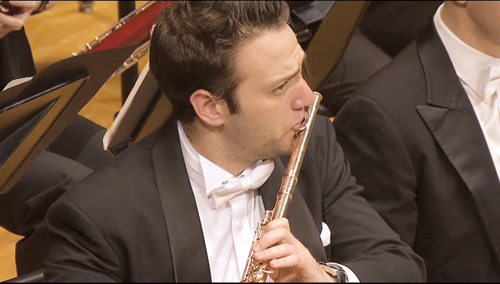
I have often wondered why soft playing is overlooked. When I was a student, fellow flutists talked about players with huge sounds and dreamed of the day when they could play louder than an entire orchestra. However, excluding instances such as playing a concerto with a full orchestra, this is a skill rarely utilized in the professional setting. As an orchestral principal flutist, I find myself playing in the piano to mezzopiano range about 75% of the time. The most stressful part of my job is never when I get to blast a tutti section, but instead when I have to come in on a pianissimo top-octave A or play a two-octave leap at a very soft dynamic, while staying in tune with the other woodwinds.
My undergraduate teacher, Joshua Smith, valued soft playing. He is a master of floating over the orchestra in Cleveland with the most elegant and beautiful sound imaginable. However, before I started studying with him, I did not understand the dynamic role of the flute in an orchestra. I wondered why the flute was not always the loudest instrument in the orchestra. Slowly as I matured as a musician, I began to appreciate and understand the beauty and nuance of orchestral balance. The flute generally has the highest part in the woodwind section so it sticks out of the texture naturally. If flutists do not heed this knowledge, it is easy for the flute to overwhelm the woodwind texture and make the whole section sound out of balance. Worse than that, this balance can actually change how audiences hear a chord. If a note is played insensitively loud, it can be easily misidentified as the tonic by an untrained listener. The flutist, as the highest and loudest instrument in the section, can actually make another player who is perfectly in tune sound out of tune.
When flutists play anything other than a solo flute piece, they are playing chamber music. The rules for playing in a small chamber ensemble apply similiarly to an orchestra. Sometimes the flute has the melody, and other times it is the accompaniment. To play accompaniment passages appropriately, flutists should learn control of soft playing throughout the entire range of the instrument.
Practice Exercises
To develop this control, practice long tones, up and down the entire three-octave register at piano and pianissimo every day, until soft playing feels comfortable. Use a tuner to check intonation. Once you can consistently play with a ringing tone and true intonation, move on to the exercises in Marcel Moyse’s De La Sonorite working on the intervallic leaps in the fourth exercise. Remember to aim the air higher on the embouchure hole wall than you would when playing loudly as this will help keep the pitch up.
Another exercise for playing softly is to practice long crescendos and diminuendos with a metronome. Set the metronome to quarter note = 80 and practice making a crescendo for eight pulses followed by a diminuendo of eight pulses. As the note gets louder, open the mouth wider and raise the soft palate by thinking of more of an O vowel. This will combat the natural tendency to go sharp as you get louder. For the diminuendo close the mouth and return to an E vowel shape. I also slightly adjust my jaw during the diminuendo, bring my lower lip ever so slightly forward, and imagine I am blowing the air up my nose. Make the aperture as small as possible as if you are whistling, and keep the air speed as fast as possible. The key to a good soft sound is to make the flute vibrate the same way as it would if you were playing loudly. This will only happen with a consistently fast air speed. Try to avoid pressing the lip plate to your lip as this creates unnecessary tension.
Adding Vibrato
Practice playing softly with varying speeds of vibrato and with no vibrato at all. Players often take out all of their vibrato in soft playing. Experiment with the opposite because sometimes a fast shimmering vibrato in the high register is more beautiful. Vibrato is a controversial subject in the flute community, but I believe a good rule is to be comfortable playing with all kinds of vibrato shapes and speeds at every dynamic level. Often a conductor will ask for more or less vibrato, and if you are not able to comfortably switch between a wide range of speeds and depths of vibratos, you will stick out for the wrong reason.
When I play with a group of winds, I find it best to use minimal vibrato. Other wind players use vibrato very differently than flutists do, and I think a wide vibrato sticks out in this texture and creates balance and pitch complications. When I play with strings, I use vibrato more freely, sometimes wide and slow and sometimes a faster more shimmery vibrato, depending on the context. If you are playing a solo passage in the orchestra, experiment with different kinds of vibrato at home before the rehearsal. Decide what you believe will work and stick to the plan in rehearsal. Feel free to take risks and make musical statements, but practice them at home many times first to make sure they will work under pressure. Then you can make small adjustments in rehearsal when you can hear the context.
There is no right or wrong way to play with vibrato. There are great flute players who use vibrato in many different ways. Listen to a favorite flutist and try to copy what he or she is doing with the vibrato at all different dynamic levels. Record yourself and decide whether what you hear on the recording is the same as what you intended. Make adjustments accordingly. Record yourself many times until what you hear on the recording matches what you hear in your head. Once you have mastered this, pick another flute player to copy and do the same thing. Do this with as many different great players as you can. Once you have mastered the different types of vibrato, you will be more qualified to make a decision on what you think is the best sound instead of just using whatever vibrato comes naturally to you. I believe the trend now is towards a more sparing use of vibrato. Be sure you can play this way in a soft dynamic to avoid a tough situation in which a conductor asks for less vibrato and you cannot execute what he asks.
Embouchure Hole
The direction in which the air is aimed on the blowing edge of the embouchure hole is also important. Many flutists roll the embouchure hole in quite a bit when playing softly. This creates resistance and makes it easier to play softly; however, it makes it impossible to play in tune. If your headjoint is rolled in too much, it will squash the overtones and create a soft but dead sound. This dead sound occurs because of the lack of overtones and makes it more challenging for other instruments to tune to you.
I line my headjoint up so that the blow hole is exactly in line with the keys. Sometimes I will make slight adjustments and cover more or less of the hole. These changes are very small and are used primarily for color choices rather than volume. Instead of rolling the headjoint in and out to create resistance, try instead to raise and lower your soft palate. I try to keep my mouth as closed as possible in all registers because I find it lets me use my air more efficiently and have more control over where it is going. If your mouth is too open in a soft dynamic, the sound becomes less focused and refined and can lack core.
If you master the art of soft playing, it will do wonders for your career. You may even come to enjoy it more than playing loudly. As you improve your versatility as a flutist, you will also notice how you can make the entire wind section sound better and not just focus on how you sound individually.






